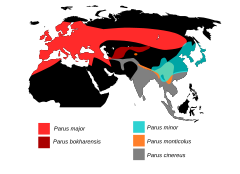Parus
| Parus[1] | |||
| Linnaeus, 1758[2] | |||
 Przedstawiciel rodzaju – bogatka zwyczajna (P. major) | |||
| Systematyka | |||
| Domena | |||
|---|---|---|---|
| Królestwo | |||
| Typ | |||
| Podtyp | |||
| Gromada | |||
| Podgromada | |||
| Infragromada | |||
| Rząd | |||
| Podrząd | |||
| Rodzina | |||
| Rodzaj | Parus | ||
| Typ nomenklatoryczny | |||
Parus major Linnaeus, 1758 | |||
| Gatunki | |||
| |||
| Zasięg występowania | |||
 | |||
Parus – rodzaj ptaka z rodziny sikor (Paridae).
Występowanie
Rodzaj obejmuje gatunki występujące w Eurazji i Afryce[3].
Morfologia
Długość ciała 12,5–15 cm; masa ciała 11,9–22,1 g[3].
Systematyka
Etymologia
Parus: łac. parus „sikora” (por. par, parum „równy, towarzysz”)[4].
Podział systematyczny
Do rodzaju należą następujące gatunki[5]:
- Parus monticolus Vigors, 1831 – sikora zielonogrzbieta
- Parus major Linnaeus, 1758 – bogatka zwyczajna
- Parus cinereus Vieillot, 1818 – bogatka orientalna – gatunek wyodrębniony ostatnio z P. major[6][7][8][9][10][11][12][13]
Przypisy
- ↑ Parus, [w:] Integrated Taxonomic Information System [online] (ang.).
- ↑ C. Linnaeus: Systema naturae per regna tria naturae: secundum classes, ordines, genera, species, cum characteribus, differentiis, synonymis, locis. Wyd. 10. T. 1. Holmiae: Impensis Direct. Laurentii Salvii, 1758, s. 189. (łac.).
- ↑ a b D.W. Winkler, S.M. Billerman & I.J. Lovette: Tits, Chickadees, and Titmice (Paridae), version 1.0. W: S.M. Billerman, B.K. Keeney, P.G. Rodewald & T.S. Schulenberg (red.): Birds of the World. Ithaca, NY: Cornell Lab of Ornithology, 2020. DOI: 10.2173/bow.parida1.01. [dostęp 2020-08-15]. (ang.).

- ↑ Parus, [w:] The Key to Scientific Names, J.A. Jobling (red.), [w:] Birds of the World, S.M. Billerman et al. (red.), Cornell Lab of Ornithology, Ithaca [dostęp 2022-01-15] (ang.).
- ↑ Systematyka i nazwy polskie za: P. Mielczarek & M. Kuziemko: Rodzina: Paridae Vigors, 1825 - sikory - Tits, chickadees (wersja: 2020-07-21). [w:] Kompletna lista ptaków świata [on-line]. Instytut Nauk o Środowisku Uniwersytetu Jagiellońskiego. [dostęp 2020-08-15].
- ↑ L. Kvist, J. Martens, H. Higuchi, A.A. Nazarenko, O.P. Valchuk & M. Orell. Evolution and genetic structure of the great tit (Parus major) complex. „Proceedings of the Royal Society B”. 270 (1523), s. 1447–1454, 2003. DOI: 10.1098/rspb.2002.2321. (ang.).
- ↑ L. Kvist, J. Martens, A.A. Nazarenko & M. Orell. Paternal leakage of mitochondrial DNA in the Great Tit (Parus major). „Molecular Biology and Evolution”. 20 (2), s. 243–247, 2003. DOI: 10.1093/molbev/msg025. (ang.).
- ↑ M. Päckert, J. Martens, S. Eck, A.A. Nazarenko, O.P. Valchuk, B. Petri & M. Veith. The great tit (Parus major) – a misclassified ring species. „Biological Journal of the Linnean Society”. 86 (2), s. 153–174, 2005. DOI: 10.1111/j.1095-8312.2005.00529.x. (ang.).
- ↑ L. Kvist, T. Arbabi, M. Päckert, M. Orell & J. Martens. Population differentiation in the marginal populations of the great tit (Paridae: Parus major). „Biological Journal of the Linnean Society”. 90 (2), s. 201–210, 2007. DOI: 10.1111/j.1095-8312.2007.00726.x. (ang.).
- ↑ S. Eck. The Palaearctic titmouse species (Aves: Paridae: Parus sensu lato) - a current survey. „Zootaxa”. 1325, s. 7–54, 2006. (ang.).
- ↑ L. Kvist & S. Rytkönen. Characterization of a secondary contact zone of the Great Tit Parus major and the Japanese Tit P. minor (Aves: Passeriformes) in Far Eastern Siberia with DNA markers. „Zootaxa”. 1325, s. 55–73, 2006. DOI: 10.11646/zootaxa.1325.1.5. (ang.).
- ↑ S. Eck & J. Martens. Systematic notes on Asian birds. 49 A preliminary review of the Aegithalidae, Remizidae and Paridae. „Zoologische Mededelingen Leiden”. 80 (5), s. 1–63, 2006. (ang.).
- ↑ N. Zhao, C. Dai, W. Wang, R. Zhang, Y. Qu, G. Song, K. Chen, X. Yang, F. Zou & F. Lei. Pleistocene climate changes shaped the divergence and demography of Asian populations of the great tit Parus major: evidence from phylogeographic analysis and ecological niche models. „Journal of Avian Biology”. 43 (4), s. 297–310, 2012. DOI: 10.1111/j.1600-048X.2012.05474.x. (ang.).
Media użyte na tej stronie
Autor: (of code) -xfi-, Licencja: CC BY-SA 3.0
The Wikispecies logo created by Zephram Stark based on a concept design by Jeremykemp.
Autor: Jakob Voß, influenced by original art designed at PLoS, modified by Wikipedia users Nina and Beao, Licencja: CC0
Closed Access logo, derived from PLoS Open Access logo. Alternative version.
Autor: Frank Vassen from Brussels, Belgium, Licencja: CC BY 2.0
Panasonic GX7 + Panasonic Lumix G Vario 100-300, O.I.S
Map of the distributions of the Parus complex based on Eck & Martens (2006) http://www.zoologischemededelingen.nl/80/nr05/a03



